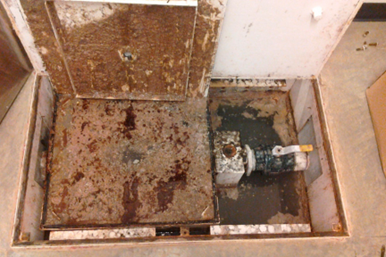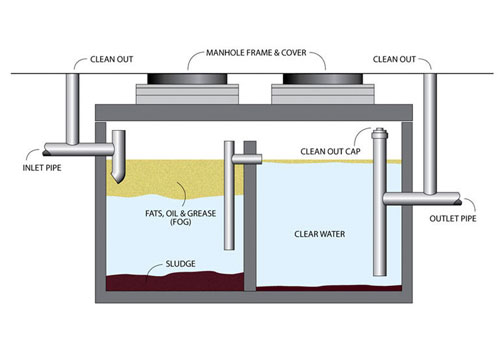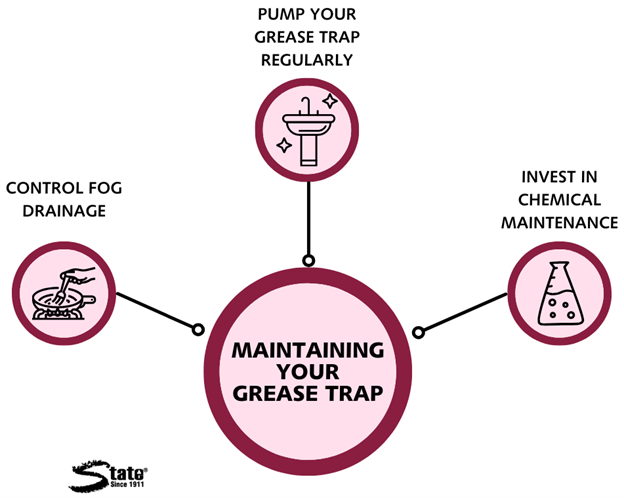What is a Grease Trap?
What is a Grease Trap?
Looking after your facility’s grease trap is important to maintaining a functioning business. But what is a grease trap? What purpose does it serve? How does it work? How do you take care of it?
State Chemical provides chemical solutions across various industries, and one of our specialties is grease trap maintainers. We know how important it is to take care of your grease trap, and we understand how confusing it can be if you don’t fully know what you’re taking care of.
In this article, we will explain what a grease trap is, its purpose, how it works, and how to take care of it. After reading, you’ll understand what this mechanism does for your facility and how to best maintain it.
What is a Grease Trap?
Also known as a grease interceptor, a grease trap is essentially a box that wastewater flows through before entering a drainage system. The grease trap serves to intercept, or “trap,” fats, oils, and greases (FOGs) so they can’t gum up pipes and cause clogs.
You may know the common items that will clog your drains, but sometimes, you can’t control the level of FOGs that go down your drain. This is especially true in restaurants, for example, where the number of dishes makes it impossible to prevent some amount of FOGs from entering the pipes. Grease traps make this drainage less harmful to your facility.
Grease traps are common in restaurants, bakeries, cafes, schools, bars, and any other facility that experiences a lot of FOG drainage. Usually, these kinds of facilities are legally required to have a grease trap because excess grease going through drainage systems will also pose problems for the city sewer.
A grease trap will either be located in a metal box under your sink, in your kitchen floor under a metal sheet, or outside your facility under a manhole cover.
How Does a Grease Trap Work?
FOGs are less dense than water, so they naturally float on top of water. Grease traps use this principle to their advantage.
When wastewater enters the grease trap, the water’s flow slows down enough that everything from your drain separates into three layers: grease floating at the top, water in the middle, and solids sinking to the bottom.
This way, the water can drain through the outlet while the grease at the top and solids at the bottom are blocked from getting through. Some grease traps also have a filter to catch solids so that fewer solids settle at the bottom of the grease trap.
After some time, the solids and FOGs will eventually build up to the point of escaping through the outlet with the water, causing buildup down the line. To avoid this outcome, you must pump out grease traps regularly, even if you also use chemical maintainers.
Why Do I Need a Grease Trap?
Grease traps are necessary in any environment where FOGs are a common presence. For example, let’s imagine that you’re the manager of a fast-food franchise. Your employees use the designated grease disposal container for fryer oil and dispose of spoiled food in the trash. Why should you need a grease trap?
Well, think about the melted ice cream at the bottom of that Tupperware or the crumbs in that baking tray or the last few fries stuck in the fry basket—all getting dunked in the sink for dishwashing. Over time, these seemingly insignificant food scraps will build up in your pipes, slowing down your drains and causing clogs.
Meanwhile, grease buildup is much more controlled when you have a grease trap—even more so when you regularly pump out your grease trap and use chemical maintenance to clear it regularly.
Most of the time, you probably don’t have a choice as to whether you have a grease trap. However, if you do have one, realize that it performs an important function. For this reason, taking proper care of it will only improve the grease trap’s functionality.
How Do I Take Care of My Grease Trap?
This begs this question: what’s the best way to take care of your grease trap?
Control Your Amount of FOG Drainage
A cost-free way to better maintain your grease trap is to control the amount of FOGs that go down your drain. This means educating your staff on what is and is not okay to put down the drain, providing grease disposal containers for unsafe items, and being cautious about what goes down the sink overall.
This is easier said than done, but if you take the time to learn what’s good and bad for your grease trap, it will be cleaner and gather less buildup.
Pump Your Grease Trap Regularly
Another way to control the amount of FOGs in your grease trap is to pump it regularly. This should happen once your grease trap is a quarter of the way full, which will usually be every one to three months.
You must pump your grease trap in order to maintain it. If you don’t, you will experience buildup and clogs, eventually requiring more serious measures in order to repair your drain system. This can be a costly chore, but ultimately, it’s worth the price if it means having a functional facility.
Conduct Chemical Maintenance
The other best way to maintain a grease trap is to conduct regular chemical maintenance. This will control the amount of buildup inside your grease trap, and your grease trap will need to be pumped less frequently. Additionally, grease trap pumping companies often charge less to pump well-maintained grease traps.
Your Next Step: Develop a Routine to Care for Your Grease Trap
Grease traps are essential to functional drains in high-FOG environments, and sometimes, it’s hard to understand just why you need them and what you need to do to take care of them. Now that you understand a grease trap’s purpose, how it works, and how to best care for it, your next step is to consider the pros and cons of chemically treating your grease trap.













